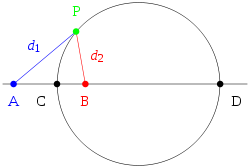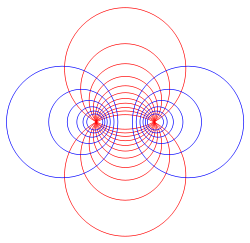- Circles of Apollonius
-
"Apollonian circle" redirects here. For a subdivision of this subject, see Apollonian circles.
The term circle of Apollonius is used to describe several types of circles associated with Apollonius of Perga, a renowned Greek geometer. Most of these circles are found in planar Euclidean geometry, but analogs have been defined on other surfaces; for example, counterparts on the surface of a sphere can be defined through stereographic projection.
The main uses of this term are fivefold:
- Apollonius showed that a circle can be defined as the set of points in a plane that have a specified ratio of distances to two fixed points known as foci. This circle of Apollonius is the basis of the Apollonius pursuit problem.
- The Apollonian circles are two families of mutually orthogonal circles. The first family consists of the circles with all possible distance ratios to two fixed foci, whereas the second family consists of all possible circles that pass through both foci. These circles form the basis of bipolar coordinates.
- Apollonius' problem is to construct circles that are simultaneously tangent to three specified circles. The solutions to this problem are sometimes called the "circles of Apollonius".
- The Apollonian gasket—one of the first fractals ever described—is a set of mutually tangent circles, formed by solving Apollonius' problem iteratively.
- The isodynamic points and Lemoine line of a triangle can be solved using three circles, each of which passes through one vertex of the triangle and maintains a constant ratio of distances to the other two.
Contents
Apollonius' definition of a circle
Main article: Circle#Circle_of_ApolloniusA circle is usually defined as the set of points P at a given distance r (the circle's radius) from a given point (the circle's center). However, there are other, equivalent definitions of a circle. Apollonius discovered that a circle could also be defined as the set of points P that have a given ratio of distances k = d1/d2 to two given points (labeled A and B in Figure 1). These two points are sometimes called the foci.
Apollonius pursuit problem
The Apollonius pursuit problem is one of finding where a ship leaving from one point A at speed v1 will intercept another ship leaving a different point B at speed v2. By assumption, the ships travel in straight lines and the ratio of their speeds is denoted as k = v1/v2. At the point they meet, the first ship will have traveled a k-fold longer distance than the second ship. Therefore, the point must lie on a circle as defined by Apollonius, with their starting points as the foci.
Circles sharing a radical axis
Main article: Apollonian circlesThe circles defined by the Apollonian pursuit problem for the same two points A and B, but with varying ratios of the two speeds, are disjoint from each other and form a continuous family that cover the entire plane; this family of circles is known as a hyperbolic pencil. Another family of circles, the circles that pass through both A and B, are also called a pencil, or more specifically an elliptic pencil. These two pencils of Apollonian circles intersect each other at right angles and form the basis of the bipolar coordinate system. Within each pencil, any two circles have the same radical axis; the two radical axes of the two pencils are perpendicular, and the centers of the circles from one pencil lie on the radical axis of the other pencil.
Solutions to Apollonius' problem
Main article: Problem of ApolloniusApollonian gasket
Main article: Apollonian gasket Figure 13: A symmetrical Apollonian gasket, also called the Leibniz packing, after its inventor Gottfried Leibniz.
Figure 13: A symmetrical Apollonian gasket, also called the Leibniz packing, after its inventor Gottfried Leibniz.
By solving Apollonius' problem repeatedly to find the inscribed circle, the interstices between mutually tangential circles can be filled arbitrarily finely, forming an Apollonian gasket, also known as a Leibniz packing or an Apollonian packing.[1] This gasket is a fractal, being self-similar and having a dimension d that is not known exactly but is roughly 1.3,[2] which is higher than that of a regular (or rectifiable) curve (d=1) but less than that of a plane (d=2). The Apollonian gasket was first described by Gottfried Leibniz in the 17th century, and is a curved precursor of the 20th-century Sierpiński triangle.[3] The Apollonian gasket also has deep connections to other fields of mathematics; for example, it is the limit set of Kleinian groups.[4]
Isodynamic points of a triangle
Circles of Apollonius may be used as a technical term to denote three special circles
 defined by an arbitrary triangle A1A2A3. The circle
defined by an arbitrary triangle A1A2A3. The circle  is defined as the unique circle passing through the triangle vertex A1 that maintains a constant ratio of distances to the other two vertices A2 and A3 (cf. Apollonius' definition of the circle above). Similarly, the circle
is defined as the unique circle passing through the triangle vertex A1 that maintains a constant ratio of distances to the other two vertices A2 and A3 (cf. Apollonius' definition of the circle above). Similarly, the circle  is defined as the unique circle passing through the triangle vertex A2 that maintains a constant ratio of distances to the other two vertices A1 and A3, and so on for the circle
is defined as the unique circle passing through the triangle vertex A2 that maintains a constant ratio of distances to the other two vertices A1 and A3, and so on for the circle  .
.All three circles intersect the circumcircle of the triangle orthogonally. All three circles pass through two points, denoted as the isodynamic points S and
 of the triangle. The line connecting these common intersection points is the radical axis for all three circles. The two isodynamic points are inverses of each other relative to the circumcircle of the triangle.
of the triangle. The line connecting these common intersection points is the radical axis for all three circles. The two isodynamic points are inverses of each other relative to the circumcircle of the triangle.Remarkably, the centers of these three circles fall on a single line (the Lemoine line). This line is perpendicular to the radical axis defined by the isodynamic points S and
 .
.References
- ^ Kasner, E., and Supnick, F. (1943). "The Apollonian packing of circles". Proceedings of the National Academy of Sciences USA 29 (11): 378–384. doi:10.1073/pnas.29.11.378. PMC 1078636. PMID 16588629. http://www.pubmedcentral.nih.gov/articlerender.fcgi?tool=pmcentrez&artid=1078636.
- ^ Boyd, D.W. (1973). "Improved Bounds for the Disk Packing Constants". Aequationes Mathematicae 9: 99–106. doi:10.1007/BF01838194.
Boyd, D.W. (1973). "The Residual Set Dimension of the Apollonian Packing". Mathematika 20 (2): 170–174. doi:10.1112/S0025579300004745.
McMullen, Curtis, T. (1998). "Hausdorff dimension and conformal dynamics III: Computation of dimension" (PDF). American Journal of Mathematics 120 (4): 691–721. doi:10.1353/ajm.1998.0031. http://abel.math.harvard.edu/~ctm/papers/home/text/papers/dimIII/dimIII.pdf. - ^ Mandelbrot, B. (1983). The Fractal Geometry of Nature. New York: W.H. Freeman. p. 170. ISBN 978-0716711865.
Aste, T., and Weaire, D. (2008). In Pursuit of Perfect Packing (2nd ed.). New York: Taylor and Francis. pp. 131–138. ISBN 978-1420068177. - ^ Mumford, D., Series, C., and Wright, D. (2002). Indra's Pearls: The Vision of Felix Klein. Cambridge: Cambridge University Press. pp. 196–223. ISBN 0-521-35253-3.
Bibliography
- Ogilvy, C.S. (1990) Excursions in Geometry, Dover. ISBN 0-486-26530-7.
- Johnson, R.A. (1960) Advanced Euclidean Geometry, Dover.
Categories:- Circles
Wikimedia Foundation. 2010.



